Whose Pizza Is It? An Armenian Adventure
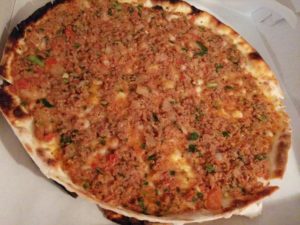
Lahmadjoune from Chez Apo. Photo by Denzil D’Sa. Instagram @reekooh.
A Lebanese friend had a bone to pick with me about eggplant. The vegetable, he said, did not originate in India, as I had written, but in his homeland. The urge to identify particular foods with one’s own ethnicity or nationality is an irresistible one. I was reminded of this exchange by an experience I had had on a recent visit to Montreal. During my stay, I had gone to visit Chez Apo, an Armenian bakery whose specialty was lahmadjoune, a product the shop called “Armenian pizza.” I was eager to find out what made their pie “Armenian.” (In this piece, I will be using “lahmadjoune,” instead of the Arabic “lahm b’ajin,” simply because of my Armenian themes.)
Over the years, I have been drawn, almost serendipitously, to Armenian food. When I lived as a young teacher on Lexington Avenue in the mid-twenties, on New York’s East Side, I discovered a restaurant, Palace d’Orient, nearby. It became a haunt of mine. At the time, I took its unusual cuisine for granted. I even gave little thought to its name, which, I later realized, evoked the alluring Middle East.
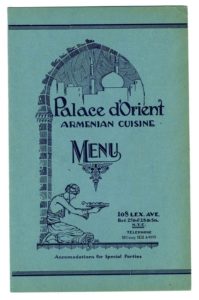
Menu of the old Palace d’Orient Armenian restaurant in New York
The small dining room had all the trappings of a luxurious establishment. At least, it seemed elegant to me, a roving bohemian attracted to snack bars and luncheonettes. Overpowered at first by the Palace, the culinary hideaway gradually grew on me.
Formally dressed waiters presided over the restaurant. They hoisted trays of dinner specials, which they delivered to well-appointed tables with white tablecloths. Platters of mussels stuffed with rice and currants and skewers of lamb shish kebab were presented to diners. I remember savoring a curious dish, baked eggplant topped with a rich tomato sauce and luxuriant with olive oil. Thinking back, it might have been imam bayildi (“the priest fainted”). Its extravagance was suggestive of the grandeur of the Ottoman Empire. Yet it was on the menu of an Armenian restaurant, whose proprietors’ forebears were members of a large Christian minority ruled by Turks. In retrospect, this was a paradox, but not one I pondered at the time.
The Palace was one of several restaurants that sprang up in Manhattan’s Little Armenia neighborhood. An Armenian Orthodox church, St. Gregory the Illuminator Cathedral, anchored the district. Several rug stores were located nearby. The restaurants have vanished, but one landmark of the old community’s retailing past remains. Kalustyan’s on Lexington Avenue between 28th and 29th Streets was opened by an Armenian businessman in 1944 to market familiar foods to his fellow ethnics. Kerope Kalustyan had planned to export steel to Turkey but decided to try his luck in the food trade.
By the 1950s, the shop’s wide selection of grains, spices, and lentils had caught the attention of new arrivals from India. Kalustyan’s was a lifeline for South Asian immigrants who had few places that carried their foods. “They were the only game in town,” Indian food writer Madhur Jaffrey told journalist Vikram Doctor. Writer Jimmy Breslin, she adds, observed how proud the owner was of carrying supari, “a kind of nut from India and Kerope may be the only one in America who stocks it.”

Basterma. Photo by Joumana Accad.
The owner shrewdly expanded its offerings to capture these new patrons. Kalustyan’s even launched its own brands of chutney and mango pickles. As Little Armenia gradually disappeared, Indian shops and restaurants took its place. The section was now dubbed “Curry Hill” (the larger area is called Murray Hill). The store has changed hands several times and is currently run by a Bangladeshi. Middle Eastern products are still for sale, but the shop is more widely known for its vast website, an online catalog of traditional as well as new-wave ethnic items. Visiting the store in 1996, food writer Regina Schrambling marveled at the emporium’s novel wares: “dried herbs on the vine from Greece and Sicily, sour cherry products to cater to Iranian customers, shelf-stable, ready-to-eat Indian meals, Irish butter alongside labneh. It has a wall of salts, from Antarctica and the Kalahari Desert and Italy and Germany and Cyprus…. It also carries a global array of even things as basic as sugar: Belgian, Balian, Japanese, jaggery, coconut, palm.”
Some years later, I ventured into an Armenian grocery store in Marseilles, a port city that is home to a large community of these ethnics. In this entrepôt for trade with the Levant, Armenian merchants had built a small colony by the early seventeenth century. In the late nineteenth and early twentieth centuries, a large influx of Armenian immigrants fleeing oppression in Turkey streamed into the city.
I was on a ramble in a multi-ethnic quarter of the city, where earlier newcomers had set up shop and which was now becoming increasingly North African. I nibbled sweets at a Tunisian bakery, peered at a plethora of spices in a Somali-owned shop, and dined at a festive Ivoirian restaurant, whose owner hugged me and introduced herself as “Mama Africa.” Soon, a pitcher of bissap, a crimson, tart, West African juice made from hibiscus, arrived at the table.
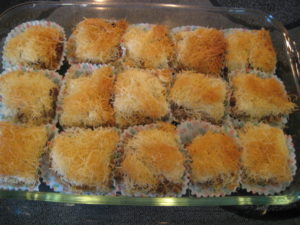
A tray of Armenian pastries, known as Kadaif. Photo by Robyn Kalajian, thearmeniankitchen.com.
Alimentation Murat, the Armenian store, represented an older immigrant era. The store, which advertised specialties of the “Orient,” was a remnant of a once-thriving commercial diaspora. The neighborhood once boasted “beaucoup” Armenians, a local told me. The grocery displayed an array of goods—chopped pistachios and other nuts, dried fruits, cherry syrup, orange blossom water, cans of okra, Mediterranean white cheese (like feta), and sweets like halva and kadaif (a pastry resembling shredded wheat). It had the flavor and atmosphere of a Middle Eastern food hall. At least one item, a dried, spiced beef called basturma, dear to Armenians, would have been a telltale sign to his clientele of the owner’s heritage.
On another food quest, digging through books for nuggets on the history of ethnic food, I chanced on a reference to Colombo yogurt. Apparently, this once exotic product, which I had first sampled at Skenderis, a former Greek grocery in Washington, had been conceived by an Armenian family. My curiosity whetted, I wanted to know more. I got in touch with Bob Colombosian, whose parents founded the business.
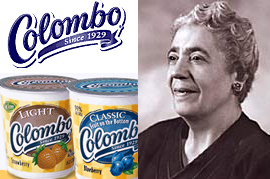
Rose Colombosian, who started Colombo Yogurt with her husband, Sarkis, in Massachusetts.
Rose and Sarkis Colombosian arrived in Lawrence, a city in northeastern Massachusetts on the Merrimack River, in the 1920s. They joined a growing Armenian community, the latest in a long line of settlers—French Canadians, Irish, Italians, Syrians—attracted by the city’s woolen mills. The Colombosians left Lawrence on the eve of the Depression, to start a dairy farm in nearby North Andover. On an impulse, they decided to peddle their homemade “madzoon” (yogurt) to Greeks, Lebanese, and Syrians in Haverhill, Lowell, and other towns with ethnic communities. In horse-drawn wagons, the vendors of the Wild Rose Dairy carried their product in quart glass bottles. They soon branched out to “mom and pop” groceries, Lebanese and Armenian shops in Lawrence. “The only place you could sell it was the ethnic stores in the beginning,” Bob recalled. They soon hit on a name for their yogurt. They called it “Colombo,” Bob said, because “nobody could pronounce their name.”
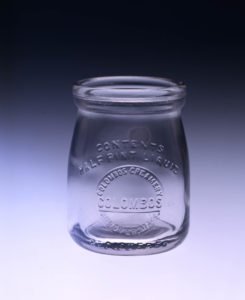
An early Colombo yogurt bottle, from the collection of the Massachusetts Historical Society.
A new client, the Mugar family, who owned two groceries in Watertown, a Massachusetts town with a large Armenian population, opened the door to a larger market for the Colombosians. The Armenian merchants who began carrying Colombo later launched Star Markets, a statewide chain. The entrée the owners gave the Colombosians to their supermarkets provided greater visibility and income.
Gradually, the Colombosians reached a wider market. By the mid-sixties, Bob and his brother decided to sweeten their brand. Although they continued to carry plain yogurt, they somewhat reluctantly adapted to American tastes. “American people like a lot of sugar,” Bob observed. The new product, a fruity custard, meant, he said, that “New customers wouldn’t spit it out when they took a bite.”
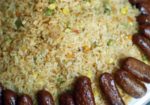
Rice pilaf with sujuk sausages. Photo by Joumana Accad.
I continued to stumble on Armenian foods. At Bacchus, an early Lebanese restaurant in Washington, DC, Usama El-Jallad, the flamboyant owner, explained the myriad items on his mezze (appetizers) menu to the uninitiated. As he ran down his roster of delicacies, flavored with mint, pomegranate molasses, sesame tahini, and other seasonings, he stopped to decipher the names of unusual dishes. One of them, sujuk, was unfamiliar to me. The tasty, spicy sausage, which he identified as Armenian, I later learned was a specialty of their kitchen.
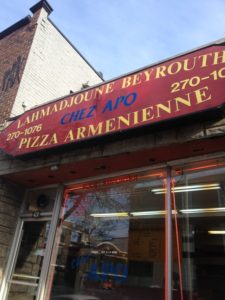
Sign over the front door of Chez Apo in Montreal, Quebec. Photo by Risa Dickens.
In the fall of 2017, I was at the doorway to Chez Apo, a tiny Armenian bakery in Montreal. I was on an expedition to uncover the mysteries of the shop’s celebrated product. Ever since I had seen “lahmadjoune” on signs in Armenian shops in the Boston area, I had been tantalized. The shop’s owners, Maro and Apo (a nickname for Abraham) Esrabian, had left Lebanon in 1976 in the aftermath of the country’s calamitous civil war. They settled in Montreal, burning with a desire to innovate, to build a different kind of business. They wanted to “start something homemade, old fashioned, something new,” Maro told me. Their enthusiasm more than made up for their inexperience: “We don’t know nothing,” Maro recounted. Drawing on their heritage, they decided to bake lahmadjoune, which they billed as “Armenian pizza.” (The word means “meat in dough.”) They fashioned the thin-crusted pie from flatbread and topped it with chopped meat and tomatoes. They seasoned their creation simply with garlic, onions, parsley, salt, and pepper. The shop’s drawing card, her late husband told writer Philip Sporzer, was a wood-fired oven. Building it would generate excitement: “In order for this to take off, I needed something so people would go ‘Wow!’ I wanted to please them and get customers. So we built the brick oven.”
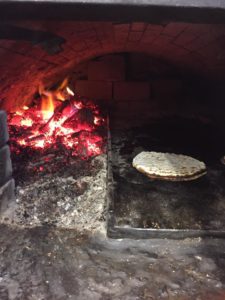
Brick oven at Chez Apo, Montreal. Photo by Fadi Sakr.
They complemented their pizza with other items, many also turned out from the oven. Customers drove to the shop to pick up maneesh za’atar, a flatbread sprinkled with a blend of thyme and sumac that is a popular Lebanese breakfast repast. They also baked spinach pizza accented with feta cheese and fatayer, a kind of Middle Eastern turnover filled with meat or spinach. The Esrabians also offered the region’s classic appetizers, hummus and baba ghanoush.
I quickly turned my conversation with Maro to the question that preoccupied me: Who created lahmadjoune? While acknowledging that the word was Arabic-Turkish, her pizza, Maro said, was distinctive: “The name is the same but the taste is different in Arab countries.” The Armenian pie was “lighter” and not as “spicy.” It was the stronger, more pungent flavor of the Arabic flatbread product that distressed her. Similarly, she felt that the taste of Lebanese za’atar was too intense.
Compared to the passionate convictions of some ethnics about lahmadjoune, Maro’s views on the pastry were measured. Opposing sides have laid exclusive claim to it. When two Armenian restaurants recently opened in Russia, Turkish loyalists were enraged by their campaign to promote the pizza as uniquely “Armenian.” Assailing the alleged imposters, Turkish television commentators declared that the lahmadjoune belonged to their country. Interestingly enough, even in Turkey, different regions have squabbled over the pie, each claiming to be its rightful parent.
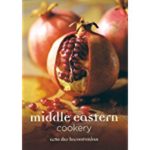
Middle Eastern Cookery by Arto der Haroutunian
Otherwise disinterested Middle Eastern food writers of Armenian background can become defiant when it comes to pizza. Arto der Haroutunian weighed in on the debate in his book, Middle Eastern Cookery: “I have never much cared for things chauvinistic, but even I, who have been brought up amongst people who, next to death, regard patriotism as a taboo subject, are obliged to scream, ‘Stop! Enough is enough!’” Lahmadjoune, he insisted, isn’t Arabic—and “that is final.” The author further argues that “to call this dish Arab because it has an Arabic name is ridiculous. The reason for its name was commercial. By that I mean when a minority lives among a majority, the former invariably uses the latter’s language for commercial purposes.”
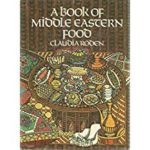
A Book of Middle Eastern Food by Claudia Roden
For some perspective on this culinary conflict, I decided to check in with two authorities on Middle Eastern food, two neutrals, neither of whom has a dog in the fight. In an email, Claudia Roden, the author of the groundbreaking A Book of Middle Eastern Food, reflects on the difficulty in assigning ancestry: “It is Turkish but also Syrian and Lebanese and you find it in other Middle Eastern countries. Some of my relatives made it at home. Jewish bakers in Egypt made it. Armenians make it too but I don’t think it originates from them.”
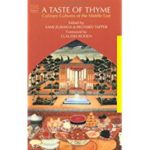
Cover of A Taste of Thyme: Culinary Culture of the Middle East, by Richard Tapper and Sami Zubaida.
Sami Zubaida, a Middle Eastern food scholar and expert on the politics and culture of the region, points out that the area’s diverse groups eat similar foods. The pie “is common in a wide region of Anatolia and the Arab Levant, until recent history inhabited by many ethnicities, Turk, Arab, Kurd, Greek, Assyrian, and Armenian,” he wrote me. “They shared a roughly common food culture.”
Their responses made me reexamine my own preconceptions. I knew from my own writing and research that food is often a product of a jumble of cultures rather than of one land or nationality. Even though I understood this argument intellectually, I frequently (as in my conversations with Maro Esrabian), looked for convenient pigeonholes for foods. I began thinking of another way of illuminating “Armenian pizza”—it belonged to the Armenians only in the sense that they put their own imprint on a shared pastry.
Armenians may not be its parents but because they were prominent bakers as well as purveyors of lahmadjoune and other Middle Eastern specialties, it was natural for many to think so. The association was an easy one to make. The Armenians, for example, controlled the “bread and pastry” trade in Aleppo, Syria for three hundred years, Sonia Uvezian, a culinary historian of the Middle East, notes.
To attempt, then, to pin down the exact genealogy of the pizza is to ask the wrong question. Zubaida puts it well: “Armenians were, and are, renowned in the region as fine cooks and caterers. As such they have excelled in many culinary fields. But that is different from attributing ‘ownership,’ which is impossible to determine. I have argued that it is geography rather than ethnicity.”
The Armenians came from a long trading tradition. Outsiders in the Middle East, they capitalized on their ancient nation’s position as a “Christian island in a Muslim sea,” to use historian Philip Curtin’s image. These “cross cultural brokers,” Curtin argues, carried goods to distant destinations. In the eighteenth century, Armenian merchants processed caviar from sturgeon eggs and shipped it to Russia. Goods from the East, like Persian silk, were transported west, to Amsterdam and other towns. They were also pioneers in the popularization of coffee. In the 1670s, an Armenian from Marseilles opened the first coffee houses in Paris and other towns, Curtin points out. They also operated most of France’s early cafés. Because of their prowess, Armenian Christians became the consummate traders and artisans in the Ottoman Empire.

Arax Market, an Armenian grocery in Watertown, Mass.
The Armenians have been especially adept in merchandising foods, whatever their origin, to receptive customers. New York City’s Kalustyan’s, as noted earlier, morphed into a grocery that targeted both Middle Easterners and Indians. In their early settlements, Armenian grocers attracted shoppers with a varied assortment of goods, without neglecting their own favorites. Historian Robert Mirak uncovered a fascinating description of one early store in Chelsea, Massachusetts: “There was merchandise strewn everywhere. Long, rigid baloneys and sausages hung from hooks in the ceiling; barrels of nuts, flour, cracked wheat, and squash seeds lined the walls. Tubs of olives and swimming Greek cheese had been shoved under tables on which rested tins of Armenian pastry, herbs and all sorts of canned stuff.”
Armenians continue to play an influential role in the food business. Most of the Lebanese restaurants and groceries that Middle Eastern food scholar Charles Perry profiled in a 1992 Los Angeles food guide were owned, he said, by Armenians. Today, the cluster of Armenian grocery stores in Watertown, Massachusetts, a town near Cambridge, attracts buyers from many backgrounds, with its cornucopia of Arabic and Mediterranean products. Her experience running Chez Apo has taught Maro Esrabian an important lesson. If she catered only to her own people, she told me, “long time ago I closed.”
Unconstrained by any and all ethnic boundaries, some Armenians have burst into the American fast food arena. In 1992, two brothers, Aro and Allen Agakhanyan, opened Big Mama’s and Papa’s Pizzeria in Los Angeles. From this early shop, they built a chain of more than twenty businesses. The brothers concocted a Giant Sicilian Pizza, a 200-slice pie, which they claim is the largest ever to be delivered. Their outlets sell pizzas along with such standbys as Philly cheesesteaks, Greek salads, chicken wings, and potato skins. Big Mama’s gained national fame at the 2014 Oscars when Ellen DeGeneres ordered their pizza to share with the luminaries.
For an article on a similar theme, see food historian Rachel Laudan’s piece, “What’s the True History of Pizza? Consider Argentina.” A collection of her writings is available at http://www.rachellaudan.com/.







